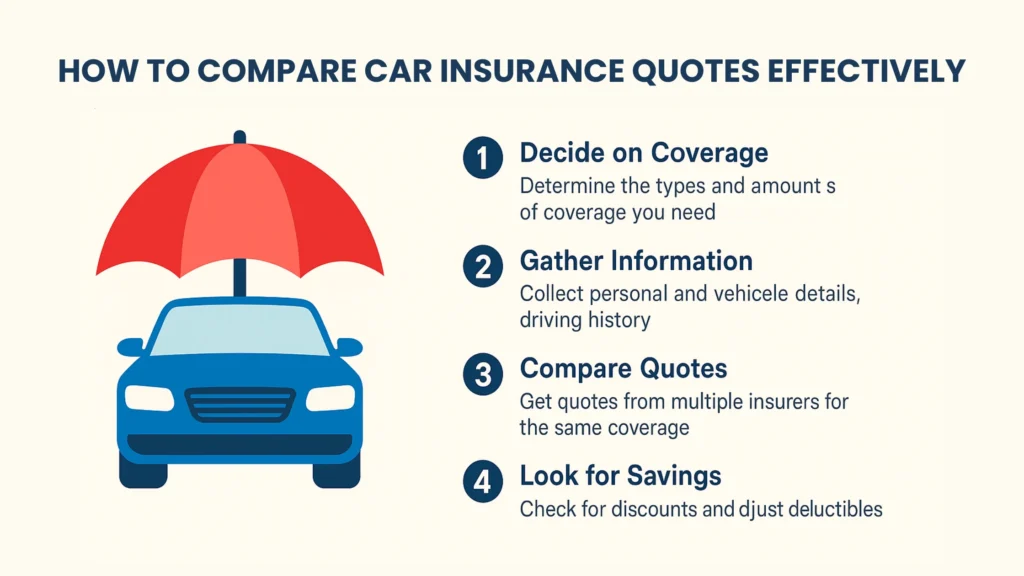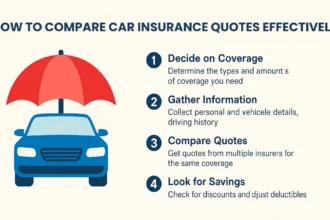
Many American drivers still pay far more than necessary for car insurance. With average premiums rising and big differences between insurers, the fastest way to save is to compare multiple quotes side-by-side, but only if you compare the right things. This guide walks you through exactly how to compare car insurance quotes effectively so you keep coverage where it matters and cut what you don’t need.
Why comparison shopping matters
- The average U.S. annual car insurance cost is in the low thousands, meaning even a 10–20% difference between insurers can save you hundreds per year.
- Cost pressures (claims severity, inflation, repair costs) have driven premium increases across the board, another reason to shop.
Step-by-step: How to compare car insurance quotes effectively
1) Decide your baseline: coverage, limits, and deductible
Before asking for quotes, pick a consistent baseline so comparisons are apples-to-apples:
- State minimums vs. recommended limits. Know your state’s required liability minimums, but consider higher limits (e.g., 100/300/100) for better protection.
- Collision & comprehensive? If you own your car outright, you might drop collision on older vehicles, but if financed/leased, you’ll likely need both.
- Deductible tradeoff. Higher deductible → lower premium. Choose the highest deductible you can afford to pay out-of-pocket after a claim.
Action: Create a “target policy” sheet listing coverages, limits, and deductibles you want; use this to request every quote.
READ ALSO: American Family Auto Insurance: Complete Review and Savings Guide
2) Gather the documents and data you’ll need
Collect once, use many times:
- Driver license numbers for all household drivers
- VIN, current odometer reading, year/make/model, safety features
- Current policy declarations page (for exact current limits)
- Accident/violation history (last 3–5 years) and prior insurance lapse info
Having these ready speeds quotes and improves accuracy.
3) Get quotes from at least 3 sources (and why)
- Direct insurer websites: fast, often instant (e.g., GEICO, State Farm, Progressive).
- Online marketplaces: one application, multiple carriers (fast but may not include every insurer).
- Independent insurance agent/broker: can access niche carriers and explain differences.
Aim for 3–6 quotes. More is better when rates are rising.
Image Alt Text: “Flat design infographic titled ‘How to Compare Car Insurance Quotes Effectively,’ showing a blue car under a red umbrella on the left and four numbered steps on the right that explain how to decide on coverage, gather information, compare quotes, and look for savings, against a beige background.”
4) Compare side-by-side (what to look for)
When you line up quotes, make sure every row equals the same thing:
- Same deductibles and limits: if one quote uses a $500 comp deductible and another $1,000, they’re not comparable.
- Coverage differences: look for endorsements (rental reimbursement, gap insurance, accident forgiveness) and exclusions.
- Out-of-pocket exposure: compare the premium and the deductible to estimate total potential cost after a claim.
- Company ratings: J.D. Power, AM Best financial strength, and BBB/customer reviews matter for claims handling.
- Discounts applied: check that all eligible discounts (multi-policy, safe driver, good student, anti-theft) were applied.
Quick comparison table sample
| Element | Quote A | Quote B | Quote C |
| Liability limits | 100/300/100 | 100/300/100 | 100/300/100 |
| Comp/Coll deductible | $500 / $500 | $1,000 / $1,000 | $500 / $500 |
| Annual premium | $1,200 | $1,050 | $1,330 |
| Discounts applied | Multi-policy, safe driver | Safe driver | Good student, anti-theft |
| AM Best rating | A | A+ | A |
| Notes | Lowest OOP if claim | Lowest premium | Best customer reviews |
(Use this as a template in your CMS or spreadsheet.)
5) Evaluate claims experience & reputation
A cheap insurer that denies or delays claims isn’t a deal. Check:
- AM Best for financial strength (ability to pay claims).
- J.D. Power and NAIC complaint ratios for customer satisfaction.
- Read sample claim stories or local forum feedback for context.
Proven ways to reduce your quoted premium
- Bundle home and auto: average bundling discounts can be meaningful.
- Ask about all discounts: multi-car, good student, alumni, military, and defensive driving.
- Usage-based programs: telematics can drop rates for safe drivers.
- Increase deductible: (only if you can afford it).
- Improve vehicle security: (anti-theft devices) and list safety features.
Mistakes to avoid
- Comparing different coverage levels (most common error).
- Ignoring company financial/reputation metrics.
- Skipping the declarations page: always use it as your baseline.
- Assuming the lowest price equals the best value.
FAQs (compact)
Do I have to provide my SSN to get quotes?
Usually only the last four digits are requested for rate accuracy; the full SSN is usually required only at purchase.
How many quotes should I get?
Aim for at least three from different sources (direct, marketplace, independent agent).
How often should I shop around?
Annually or after major life changes (move, new car, ticket, marriage).
Conclusion: take action today
Comparing car insurance quotes effectively means comparing the same coverages, checking insurer reputation, and using discounts strategically. Start with your target policy, gather accurate info, get 3–6 quotes, and use the comparison table above to pick the best overall value, not just the lowest price.
In another related article, Nationwide Auto Insurance: Guide to Rates, Coverage & Savings





